When was the last time you looked at your job description marketing with fresh eyes? (And, yes, before you ask, job descriptions are definitely a form of marketing.) As a key player in the recruitment process, your role in crafting engaging job descriptions is crucial. If you randomly pulled up one of the listings for a current opening at your company, would you be excited enough to apply … or would you keep scrolling?
Most of us don’t think twice about spending 30 minutes to draft a LinkedIn post or a couple of hours to draft a drip-email message, but—when it comes to writing job descriptions—we’ll often just dust off an old template, update a few bullets, and call it a day.
This post, which is part of our recruitment marketing series, explores why you should treat job descriptions like powerful marketing assets rather than administrative formalities. By using today’s best tools to transform how you attract and build exceptional teams completely, you have the power to significantly impact your company’s success. If hiring is one of your top priorities, implementing effective recruitment marketing strategies can help you stand out in a competitive job market and position your organization for growth. Other articles in this series include:
- Bringing proven marketing techniques to your hiring process
- Improving career web pages
- Using recruitment marketing automation to reach top talent
Continue reading for expert tips on crafting job listings that attract top talent, leveraging proven marketing principles throughout the recruitment funnel, and more.
Job descriptions are more than just HR paperwork
So you have an open position to fill. You know the requirements of the role, and you have a solid understanding of the qualifications needed for the job. You’re ready to make a list of the responsibilities, add the required boilerplate about the company, include compliance requirements, and you’re good to go.
It’s not that simple. Quality and creativity matter because they’re what help you stand out. Often, by the time a job requisition opens, the motivation to fill the position quickly is strong. And, all of this moving quickly often results in using templates that often feature outdated information or internally focused language. But what if you could break free from these constraints and write job descriptions that truly inspire?
The result? Job boards across the web are filled with lackluster role descriptions.
But when you consider the phases of the candidate journey below, it’s clear that the role of the job description is much more than just another piece of HR paperwork.
If you switch your mindset and approach writing a job description like how a marketing pro crafts campaign messaging, you’ll find that your work attracting top talent gets a lot easier.
These job descriptions are typically the candidate’s first point of interaction with your company and brand, and first impressions matter.
Where do most job descriptions go wrong?

Job descriptions are often written by the company for the company. The typical description of job duties and responsibilities is often built on internal jargon and may even include the use of company-specific acronyms that can be confusing. Admittedly, it can be hard when you’re trying to answer the question, “What do we need in this role?” not to focus internally.
Furthermore, many job descriptions are compliance-heavy in order to avoid legal issues. Important? Of course. But when a job description is dominated by compliance information, it can create a specific interpretation of your brand (and maybe not the one you want).
Example of internal speech
The candidate must possess advanced cross-functional collaboration skills, with a demonstrated ability to execute in matrixed environments.
Why it’s a problem: It’s confusing, generic, and tells the candidate nothing about what they’ll actually do or why it matters.
Oftentimes, job descriptions sound the same. They lack personality and differentiation that can be used to reflect your culture and mission and help the candidate understand why they would want this specific role at your company (and not somewhere else).
When job descriptions simply become a laundry list of responsibilities, they miss a significant opportunity to sell the role (and the company) to the candidate. In a job market where talent is highly in demand, this can mean missing out on the best candidates.
Finally, job descriptions may be distinctly disconnected from the rest of the brand. Many organizations are brand-aware and go to great lengths to ensure that their marketing collateral, websites, and social channels follow strict employer brand guidelines, presenting a united and cohesive voice and identity. However, job descriptions are frequently created and presented outside this brand ecosystem.
Take a marketing approach to job descriptions
So, how can you create good job descriptions that serve as an extension of your employer brand and position your company more attractively to potential employees? It starts with fundamentally changing the way you approach and create your job role write-ups. Here’s what that looks like, step by step.
Think like a marketer, not just a hiring manager
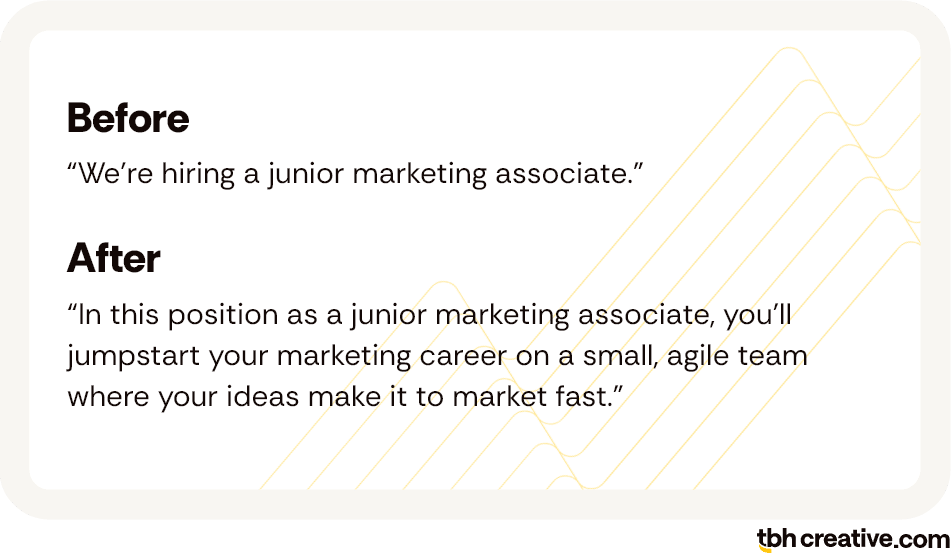
All good recruitment marketing plans start by defining your audience. Understanding who you are trying to reach and, above all, what matters to them, is essential for any effective marketing work supporting employee recruitment strategies. This is the same approach you should take when putting together your job descriptions.
The first and most important question you should answer is, who are you trying to reach? Then, use language that speaks to their motivations and values. Junior software engineers will be motivated differently from senior-level developers. Highlight the benefits of the position (and the company) that speak to them.
Perhaps this means that for a more junior role, you should focus the job description on the career advancement opportunities of the position and the company’s ongoing education programs. In contrast, the more senior position emphasizes the flexibility of the role and its strategic responsibilities. You want to focus on the benefits (the right benefits) and not just the role’s requirements.
Before
“We’re hiring a junior marketing associate.”
After
“In this position as a junior marketing associate, you’ll jumpstart your marketing career on a small, agile team where your ideas make it to market fast.”
Structure and voice matter
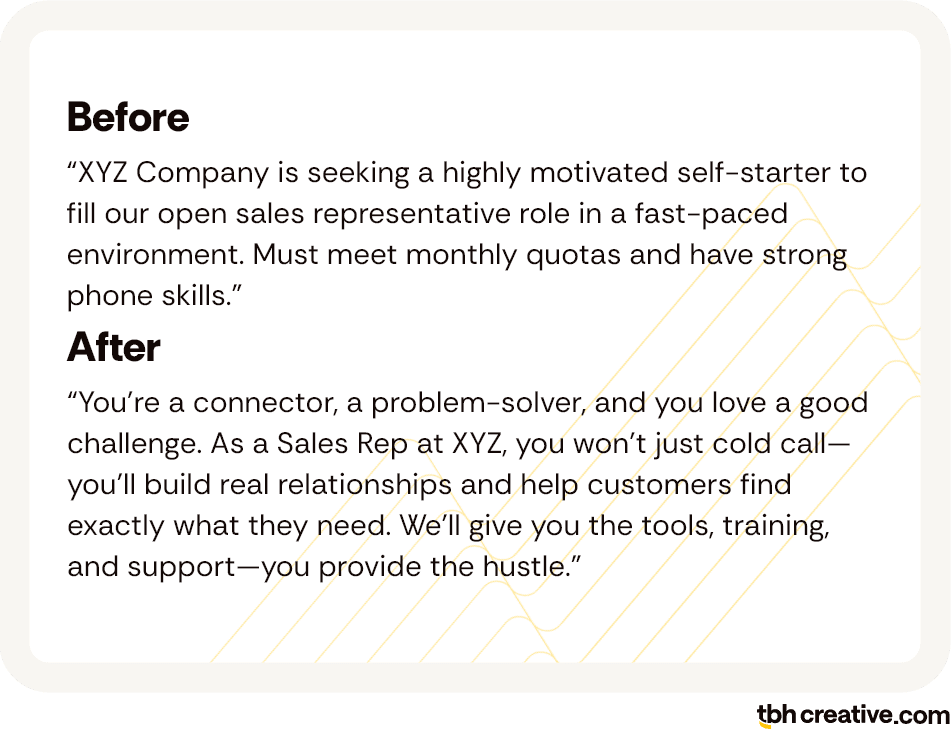
Like everyone, job seekers are often pressed for time. According to Insight Global, job seekers spend an average of only 14.6 seconds reading the requirements or qualifications section of an employment job description.
For better or for worse, digitalization has shortened our attention spans. You need to use a clear and skimmable layout that quickly helps readers determine if this position is a good fit for them. Consider using a hook or a “why you should care” section in the introduction.
At the very least, the introduction should be engaging and interesting to read, providing the potential employee with an incentive to continue.
Before
“XYZ Company is seeking a highly motivated self-starter to fill our open sales representative role in a fast-paced environment. Must meet monthly quotas and have strong phone skills.”
After
“You’re a connector, a problem-solver, and you love a good challenge. As a Sales Rep at XYZ, you won’t just cold call—you’ll build real relationships and help customers find exactly what they need. We’ll give you the tools, training, and support—you provide the hustle.”
Provide a company and team overview that uses a brand voice and personality that helps your company stand out. Define role responsibilities not only as a list of tasks, but frame them in a way that allows the job seeker to understand the impact they will have in the organization.
When it comes to qualifications, specify whether they are “must-haves” or “nice-to-haves.” Finally, emphasize the perks, benefits, and cultural differentiators that make your workplace one in which employees thrive.
How to use voice to build better job descriptions
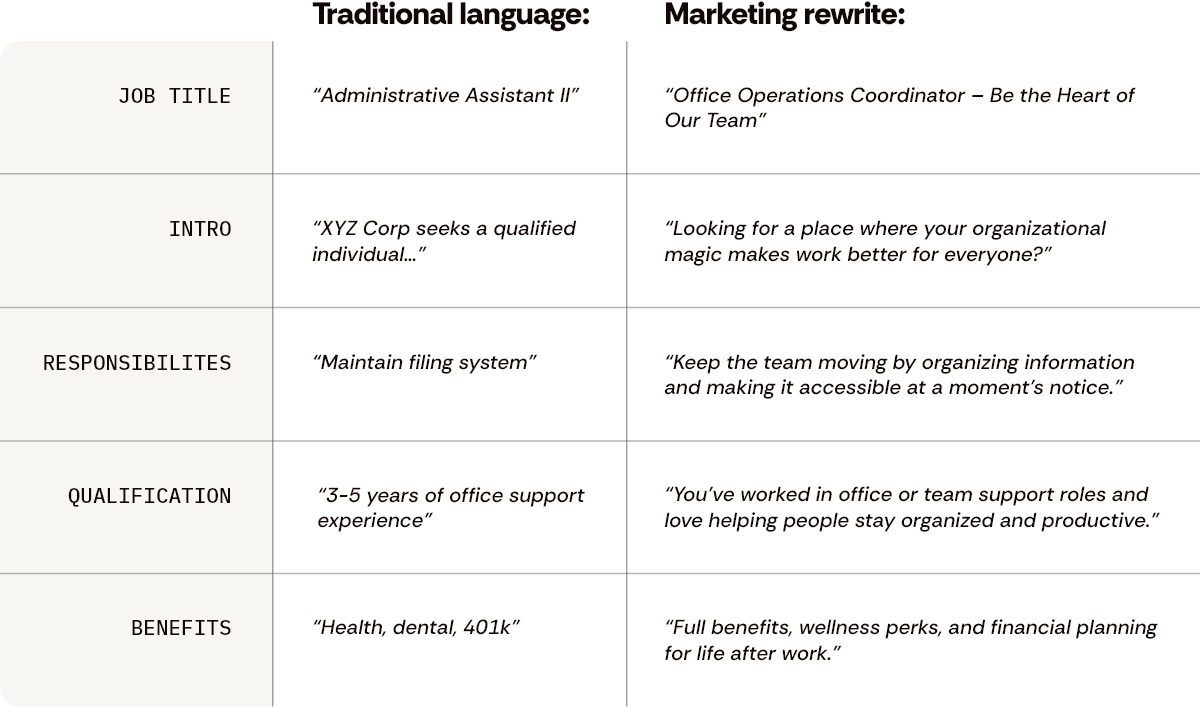
Show, don’t just tell
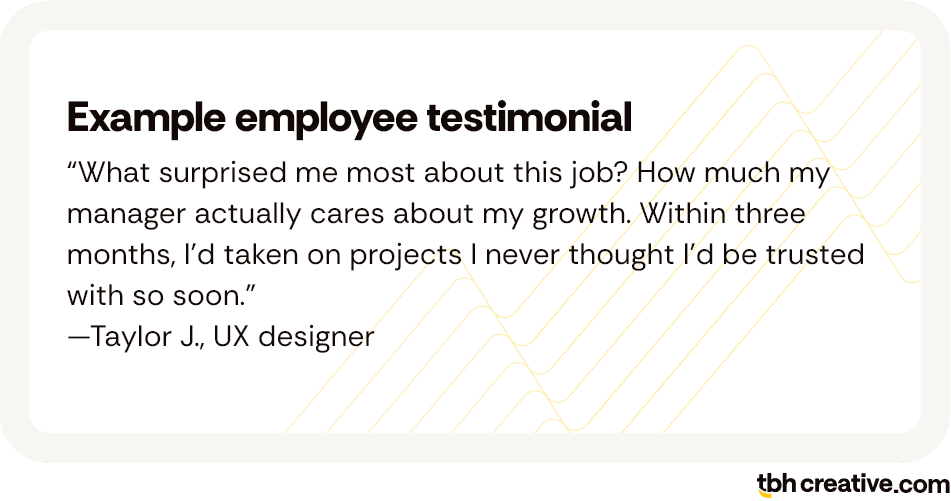
In general, audiences are more cautious about marketing than ever, and that includes recruitment marketing. It’s so easy for organizations to talk about how good they are, but it can be difficult for candidates to find that information trustworthy on its own. You can help combat this cynicism by using a “show, don’t just tell approach.”
Start by incorporating quotes from current employees or using testimonials. Potential employees want to hear from current workers. There’s a reason that sites like Glassdoor now boast an average of more than 60 million monthly unique visitors.
Using employee quotes will build trust that the marketing in your job descriptions is reliable and trustworthy. Imagine how much value an employee testimonial like this would bring to your job description:
Example employee testimonial
“What surprised me most about this job? How much my manager actually cares about my growth. Within three months, I’d taken on projects I never thought I’d be trusted with so soon.”—Taylor J., UX designer
Another approach is to use narrative snippets to describe what a day in this role looks like. This helps potential applicants imagine themselves in the position and envision how they would work in your company in a real, tangible way.
Narrative example
“On a typical Tuesday, you might start your morning catching up on overnight messages from our APAC team, then lead a short virtual huddle with your pod to prioritize the day’s work. By lunch, you’ll have wrapped up a draft campaign brief and scheduled content reviews—all before diving into brainstorming for our next product launch.”
Finally, link to blog posts, videos, or social content to help build a cultural ecosystem around the position. By creating a richer user experience, you help drive additional engagement in your job listings and start building relationships with potential applicants.
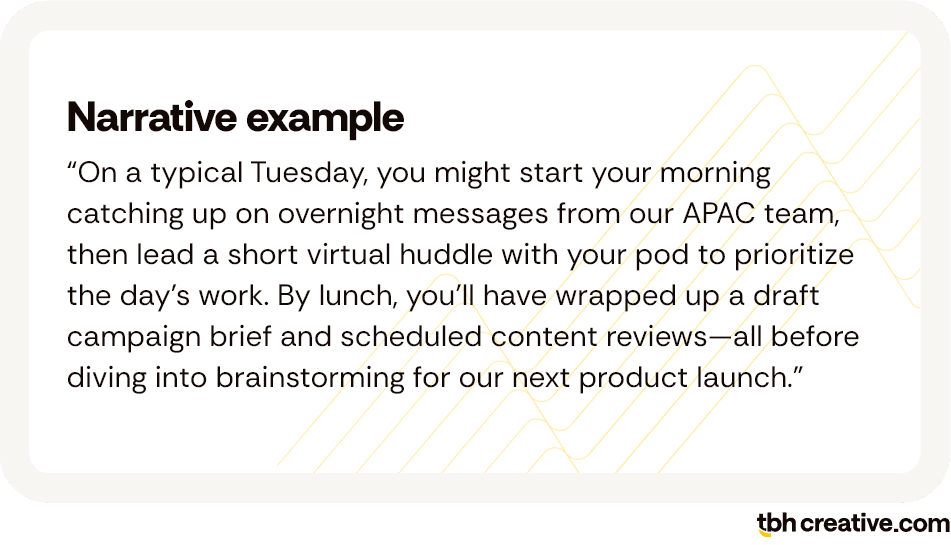
Bonus points if the blog or posts center on a topic particularly relevant to the position, like:
Embedded CTA example
Want to see what your future teammates are working on? Check out our design blog!
Where AI can help
Inclusive job descriptions are essential, and AI tools (such as Textio or Grammarly Business) can help optimize tone and inclusivity to ensure your writing is tailored to audiences of all backgrounds.
ChatGPT, Claude, and Jasper are great for drafting first drafts or making edits for specific role variations and can help to standardize your voice across various departments or locations. But using AI comes with a warning of caution.
Just like all writing, AI can dehumanize your brand if not deployed thoughtfully and strategically. Job seekers will be able to tell if you rely on AI for all your job descriptions and will naturally wonder what other corners you may be cutting. Always deploy human resources to polish and finalize any descriptions to help them kickstart a real (human) user experience.
Putting it all together
Like much of digital marketing, impact in recruitment marketing is best driven by a focus on being customer-centric, which means a fundamental shift in how you think about your job descriptions.
Looking at job postings as marketing content and encouraging your teams to audit their own job descriptions for tone, structure, and value proposition will be an important first step in getting more out of your recruitment marketing.
The next post in this recruitment marketing series dives into how to build career pages that convert. You won’t want to miss it.
In the meantime, need help rethinking your recruitment marketing strategy? Let’s talk.

